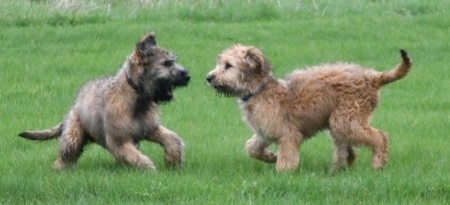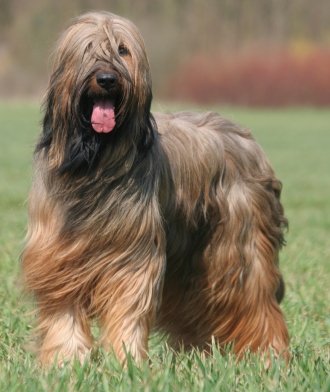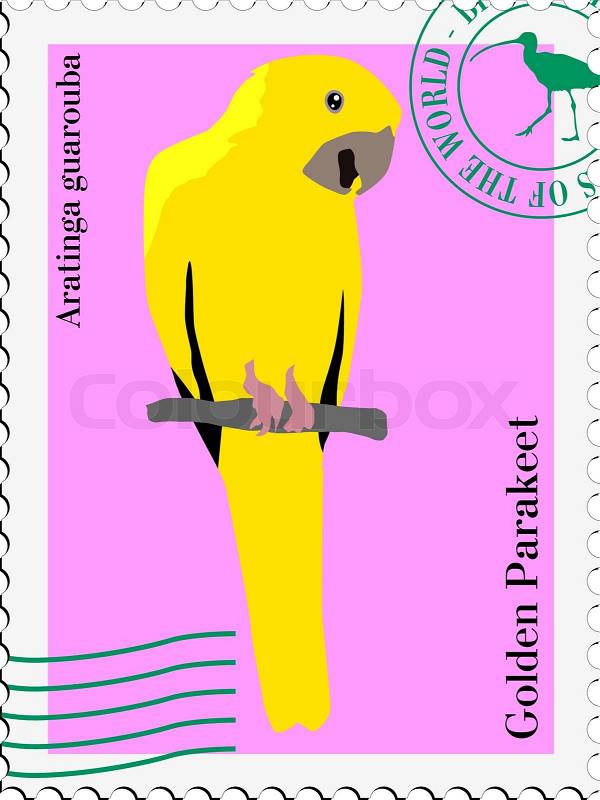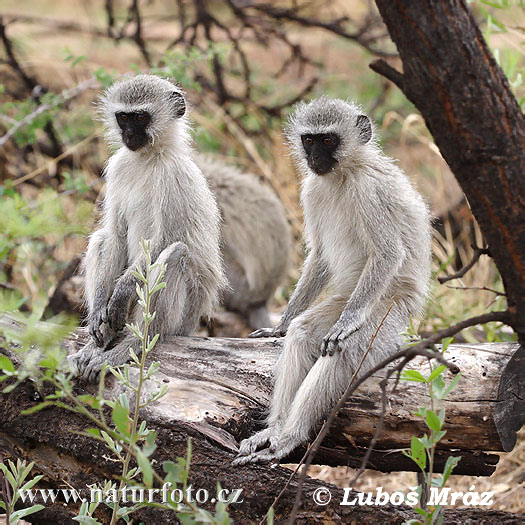The Briard has a strong and powerful stature combined with the agility needed for a herding dog. The head of the Briard should give the impression of length with clean lines and no excess skin or jowls. The head should also be held high and alter and should connect to the neck at a 90 degree angle. The ears should be set high on the head and should have a thick leather to be firm at the base. The ears can be either cropped or not cropped. The muzzle has a moustache and beard and should be considered somewhat wide and end in a right angle. Their muscular build is emphasized in their chest. The chest is broad and deep with moderately curved ribs. The shoulder blades are to be long and muscular. The front legs and rear legs are to be the same distance apart. The legs are to be straight and parallel to the median of the body. The form of the legs is very important because they are what will determine the dog's ability to herd and keep its agile movement. The rear legs are very powerful and help provide flexibility. The rear legs are to have two dewclaws that are lower set on the leg. This will give foot the appearance of having a wide base.
 |
| A STAMP OF A BRIARD |
The Briard's coat is very coarse and strong. It is slightly wavy double coat. It is really similar to the coat of goats. Dirt and water do not easily attach to the coat. The coat if well groomed sheds very little. The average length of an adult Briard's coat is at least 6 inches. The length of the coat gives it a very attractive bushy appearance with a beard, moustache, and eyebrows. The undercoat of the Briard is much finer than that of the outer coat. Due to the softness and fineness of the undercoat it is prone to matting. The coat can be worn either long or shorter depending on owner's preference and level of coat maintenance desired.
 |
| MOTHER BRIARD AND HER TWO LITTLE PUPS |
The Briard is a very loving and loyal dog. They are extremely intelligent without a hint of shyness. They are said to be a dog of heart with a light spirit and who become very loyal to their owners and families. They loyalty extends into being protective of their family as well so introductions to new people and animals should always be on the dog's terms. This includes new introductions into the family such as furniture or a new child. The Briard needs to be shown that new introductions are a positive experience. Further to this, socialization is very important with the Briard because of this protective nature. Socialization should start an early age and should consist of meeting all different kinds of people and going to several different types of places. If living in a home with children they are very loving and gentle when raised together. This is the same for other animals. The Briard is known to be a bit dog aggressive, but with proper socialization and handling can co-exist with other pets and animals well.The Briard is definitely not a dog for everyone. They can be very stubborn and independent and sometimes very unfriendly and fearful when not raised properly. They respond very poorly punishment or severe training. They can become very withdrawn and sometimes even violent when treated negatively. It is important to train them using a more positive approach. Clicker training and food reinforcement training are examples of positive training methods. This breed is very sensitive to being teased. Further to this, because of their training and history of being herding dogs, Briards are likely to nip at people's heels with the intentions of herding them where the dog thinks they should go.When raised properly are very affectionate and warm family dogs. It is said that they will return ten fold the amount of affection that they are given. They do crave excitement and entertainment and therefore are not the type of dog that can just be left to roam and relax around the house. It is important for the Briard to have daily exercise and entertainment. Their love of the outdoors and for activity makes them excellent pets for the active individual or family.
 |
| TWO BRIARD PUPS PLAYING TOGETHER |







.jpg)







.jpg)